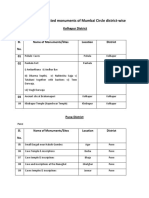Blockchain Technology: A Comprehensive Overview
1. Introduction
Blockchain technology is a revolutionary advancement in digital infrastructure, initially devised for the
cryptocurrency Bitcoin. It has since evolved to support various applications across multiple sectors. At its
core, blockchain is a decentralized, distributed ledger that records digital transactions across many
computers in a way that the registered transactions cannot be altered retroactively.
2. What is Blockchain?
A blockchain is a chain of blocks, each containing data, a timestamp, and a cryptographic hash of the
previous block. This design ensures data integrity and transparency. Each participant in the network has
access to the ledger, which makes it almost impossible to tamper with data unnoticed.
3. History and Evolution
The concept of blockchain was introduced by a person or group using the pseudonym Satoshi Nakamoto in
2008. Originally created for Bitcoin, it has since grown beyond cryptocurrencies. Ethereum introduced smart
contracts, which expanded the technology's potential into programmable transactions.
4. Key Components of Blockchain
• Block: Contains data, the hash of the block, and the hash of the previous block.
• Chain: A series of linked blocks.
• Node: Any computer participating in the network.
• Ledger: A complete copy of the blockchain data.
• Consensus Mechanism: A process for achieving agreement among nodes (e.g., Proof of Work, Proof
of Stake).
5. Types of Blockchain
• Public Blockchain: Open to all; examples include Bitcoin and Ethereum.
• Private Blockchain: Restricted access; used by businesses.
• Consortium Blockchain: Controlled by a group; suitable for collaboration among organizations.
• Hybrid Blockchain: Combines features of both public and private blockchains.
1
�6. How Blockchain Works
1. A transaction is requested.
2. The transaction is broadcast to a network of nodes.
3. Nodes validate the transaction using a consensus algorithm.
4. A new block is created and added to the chain.
5. The transaction is complete and recorded.
7. Blockchain vs Traditional Databases
Feature Blockchain Traditional Database
Structure Decentralized, distributed ledger Centralized
Data modification Not easily altered Easily updated
Transparency High Limited
Security High (cryptographic) Moderate
8. Advantages of Blockchain
• Transparency: All transactions are visible to participants.
• Security: Data is encrypted and immutable.
• Efficiency: Reduces need for intermediaries.
• Traceability: Transactions can be audited.
• Decentralization: No single point of failure.
9. Disadvantages of Blockchain
• Scalability: Limited number of transactions per second.
• Energy Consumption: High in Proof of Work systems.
• Complexity: Steep learning curve.
• Regulatory Issues: Legal frameworks are still evolving.
• Data Privacy: Public ledgers may conflict with privacy laws.
10. Applications of Blockchain
• Cryptocurrencies: Bitcoin, Ethereum.
• Smart Contracts: Automated, self-executing contracts.
• Supply Chain: Transparency and tracking of goods.
• Healthcare: Secure sharing of patient data.
• Voting Systems: Secure, tamper-proof elections.
2
� • Finance: Faster settlements, reduced fraud.
11. Smart Contracts
Smart contracts are self-executing contracts with terms written directly into code. These run on the
blockchain and execute automatically when conditions are met, removing the need for intermediaries.
12. Future Trends
• Integration with AI and IoT
• Development of Web3
• Expansion of DeFi (Decentralized Finance)
• Tokenization of Assets
• Sustainability-focused consensus mechanisms
13. Use Cases in Various Industries
• Real Estate: Digital property records and transactions.
• Education: Secure academic records.
• Logistics: Real-time tracking.
• Energy: Peer-to-peer energy trading.
• Insurance: Fraud prevention and claims processing.
14. Challenges to Adoption
• Technical barriers
• Interoperability issues
• Resistance to change
• Lack of regulatory clarity
• Initial implementation costs
15. Conclusion
Blockchain technology is transforming how we store, share, and secure data. While it offers significant
advantages in terms of transparency, security, and efficiency, it also faces several challenges. As the
technology matures, it is expected to become a foundational element of future digital systems.


























































































